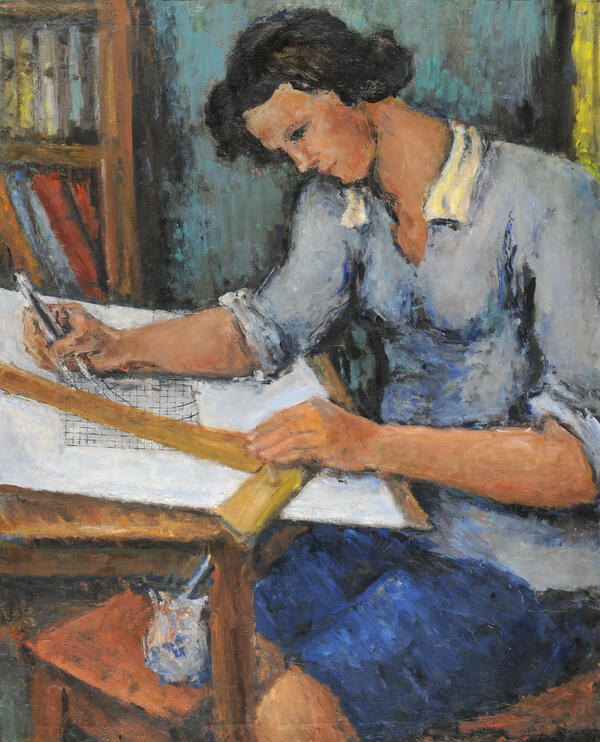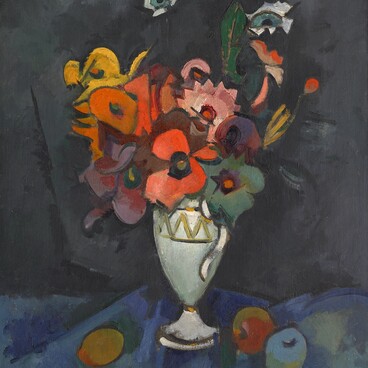The creative work of Viktor Markovich Midler remains a page in the history of Russian twentieth-century art that has not been well studied. A remarkable painter, graphic artist, and talented art critic, he belongs to that generation of artists who, having acquired their professional skills in the pre-revolutionary period, began to work independently after the 1917 October Revolution. In the 1920s, enthusiastically embracing the changes taking place in the country, the young artist actively became involved in the cultural part of building the Soviet republic: on instructions from Lunacharskiy, the People’s Commissar for Education, he inspects the work done by regional art clubs, and in 1918-1923, while living in Central Asia, he works toward restoring the monuments in Samarkand, and then, after returning to Moscow, he became the organizer and curator for the department with the latest in Russian painting at the State Tretyakov Gallery.
During all that time, despite the wide scope of his social activities, Midler had kept working as an artist. A trip to France and Germany in 1927 turned out to be very significant for the formation of his creative identity.Gradually, the master’s creative credo was formed, which led him to the « Four Arts » group. n Midler’s works, the aesthetic principles of this association manifested themselves in the assertion of the intrinsic value of painting, in the desire to regard any narrative as a reason to resolve objectives inside the art world above all else.
This desire is palpable in his painting called University (1935), which represents the image of a young woman characteristic of her era, grasping the principles of scientific knowledge. The painter demonstrates, first of all, the social role of his model, without setting the objective of giving it a deep psychological description. The co- ed’s clothing is as typical of the 1930s as its social role: a navy blue skirt, and a blue-gray sports shirt with a white collar, evoke the idea of sports, which were as actively encouraged by the state as receiving a higher education was. The strong figure, tanned face, broad shoulders, and large, strong arms that the woman has all seem to support this assumption. In the figurative manner of Midler’s painting, his experience with mastering the creative principles of the « Jack of Diamonds » group is combined with techniques typical of impressionism. In artwork in the 1920s and 1930s, educational topics were some of the most relevant. The fact is that to implement the plans for the country’s forced industrial development, Soviet power required a large number of qualified specialists capable of solving complex technical problems. Gradually, a new social type represented by an educated, active, and confident young person, inspired by the ideas of building a bright future, was formed in society. Many artists strove to embody that in their artwork, creating whole portrait galleries with many various workers’ school students and university co-eds.
During all that time, despite the wide scope of his social activities, Midler had kept working as an artist. A trip to France and Germany in 1927 turned out to be very significant for the formation of his creative identity.Gradually, the master’s creative credo was formed, which led him to the « Four Arts » group. n Midler’s works, the aesthetic principles of this association manifested themselves in the assertion of the intrinsic value of painting, in the desire to regard any narrative as a reason to resolve objectives inside the art world above all else.
This desire is palpable in his painting called University (1935), which represents the image of a young woman characteristic of her era, grasping the principles of scientific knowledge. The painter demonstrates, first of all, the social role of his model, without setting the objective of giving it a deep psychological description. The co- ed’s clothing is as typical of the 1930s as its social role: a navy blue skirt, and a blue-gray sports shirt with a white collar, evoke the idea of sports, which were as actively encouraged by the state as receiving a higher education was. The strong figure, tanned face, broad shoulders, and large, strong arms that the woman has all seem to support this assumption. In the figurative manner of Midler’s painting, his experience with mastering the creative principles of the « Jack of Diamonds » group is combined with techniques typical of impressionism. In artwork in the 1920s and 1930s, educational topics were some of the most relevant. The fact is that to implement the plans for the country’s forced industrial development, Soviet power required a large number of qualified specialists capable of solving complex technical problems. Gradually, a new social type represented by an educated, active, and confident young person, inspired by the ideas of building a bright future, was formed in society. Many artists strove to embody that in their artwork, creating whole portrait galleries with many various workers’ school students and university co-eds.



